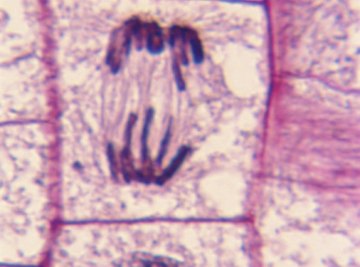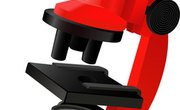
Yeast is a ubiquitous, living organism belonging to the fungus kingdom. Like other eukaryotic organisms, the yeast cell has a well-organized nucleus bound in a membrane. The nucleus contains double-stranded chromosomes that pass along DNA during reproduction. Unlike plants, yeast are heterotrophs that do not have chlorophyll, a vascular system or a cell wall made of cellulose.
What's Unique About Yeast?
The cell structure and function of yeast sets it apart from cells in plants, animals and bacteria. Yeast is a prolific, single-celled fungus that plays a major role in the food, beverage and pharmaceutical industry. According to the Confederation of European Yeast Producers, there are 10 billion microscopic fungi cells in just 1 gram of yeast. Although eating a living or dead fungus may not sound appetizing, remember that mushrooms on the salad bar are fungi, too.
Yeast Cell Cytoplasm
When yeast cells are deprived of food, the cytoplasm in the cells becomes more acidic and proteins interact, causing the cytoplasm to become less fluid. Cell activity then slows to preserve the cell in the absence of an energy source. For instance, a package of dry yeast purchased at the store sits dormant until conditions for growth are right. Yeasts cells wake up in a hurry when a cook adds warm water and a bit of sugar.
Yeast Cellular Wall
The cell wall determines the shape of the cell and provides protection against threats in the environment. Polysaccharides like chitin in the cell wall provide strength and support. Chitin plays a role in normal cell division. Yeast cell walls also contain mannoproteins.
Yeast Cell Vacuoles
Vacuoles are large spaces in the yeast cell containing enzymes in a slightly acidic environment. According to a journal article in Cellular Logistics, the vacuole in the cytoplasm makes up around 20 percent of cell volume in a yeast cell. Functions include breaking down protein and other complex molecules, storing nutrients and maintaining homeostatis.
Yeast Cell Mitochondria
Mitrochondria in yeast cells play a similar role to mitochondria in plant and animal cells. All living organisms depend on the mitochondria to produce energy for respiration, growth and homeostasis. Within the two membranes of the mighty mitochondria, glucose from food is broken down and the chemical energy converted to the bonds of adenosine triphosphate (ATP) through the process of oxidative phosphorylation.
Yeast Cell Endomembrane System
Parts of a yeast cell include an endomembrane system that manages traffic in the cytoplasm of the cell. Key players include the Golgi apparatus, endoplasmic reticulum and ribosomes. The endomembrane system is involved with sorting, modifying and transporting molecules between organelles, the outer membrane and the cell nucleus.
Function of Yeast Cell
Yeast makes it possible for you to enjoy a tasty loaf of bread with cheese and wine. Baker’s yeast and brewer’s yeast (Saccaromyces cerevisae) along with many other types of yeasts have been used for centuries by bakers, cheesemakers and master brewers.
Activated yeast feeds on sugar and produces carbon dioxide gas. When bread dough is kneaded and heated, the stretchy gluten in flour fills with countless carbon dioxide bubbles. Starch in flour reinforces the structure of gluten bubbles and absorbs water during baking, transforming gooey dough into delicious leavened bread.
Yeasts are highly adaptable to many types of conditions and environment. When deprived of oxygen, yeast can make energy through the process of fermentation. Sugar, starch and water molecules are broken down through glycolysis, with alcohol and carbon dioxide as byproducts. Fermentation is what produces the alcohol in beer, wine and other alcoholic beverages.
Applications to Science and Medicine
The yeast cell’s genome has been carefully deciphered, making it ideal for use in genetic studies, according to NASA Science. Scientists are working to learn more about how genes switch on and off and respond to toxins. Yeast is also used to produce pharmaceutical drugs and vitamin supplements. Antifungal drugs treat overgrowth of yeasts such as candida in the human body.
References
- NASA Science: Planets in a Bottle – More About Yeast
- COFALEC: The World of Yeast
- Fighting With Food: Yeast: A Mighty, Tiny Fungus
- Genetics: A Genome-Wide Map of Mitochondrial DNA Recombination in Yeast
- Washington University in St. Louis: Energy for the Body: Oxidative Phosphorylation
- 21st Century Guidebook to Fungi: 5.11 The Endomembrane Systems
- Cellular Logistics: The Proteolytic Landscape of the Yeast Vacuole
About the Author
Dr. Mary Dowd studied biology in college where she worked as a lab assistant and tutored grateful students who didn't share her love of science. Her work history includes working as a naturalist in Minnesota and Wisconsin and presenting interactive science programs to groups of all ages. She enjoys writing online articles sharing information about science and education. Currently, Dr. Dowd is a dean of students at a mid-sized university.
Photo Credits
Jupiterimages/Photos.com/Getty Images
